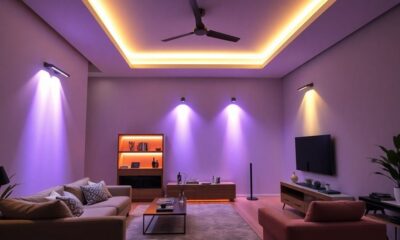Home Decor
Statement Ceilings: The Fifth Wall Revolution
Incorporate bold designs and textures into your ceilings to transform your space—discover how this often-ignored element can redefine your home’s ambiance.

Statement ceilings are revolutionizing design by turning an often-overlooked space into a stunning focal point. By embracing bold colors, intricate patterns, and unique textures, you can redefine a room's ambiance. Consider using wood paneling or embossed tin tiles to add depth and character. Light hues expand smaller spaces, while darker shades create a cozy retreat. Integrating artistic elements, like murals or coffered designs, elevates the ceiling's impact. This fifth wall can truly set the mood and style of your home. Stick around to discover even more ways to make your ceilings stand out in enchanting ways.
Key Takeaways
- The ceiling, regarded as the "fifth wall," can significantly enhance a room's aesthetics and ambiance through innovative designs and materials.
- Statement ceilings utilize bold colors, intricate patterns, and textures to create captivating focal points that redefine interior spaces.
- Architectural enhancements like coffered and vaulted ceilings add luxury, character, and depth to the overall design.
- Integrating ambient lighting and artistic elements transforms ceilings into striking visual features that elevate the atmosphere of any room.
- Current trends emphasize minimalist designs, eco-friendly materials, and multifunctional spaces that promote sustainability and comfort in ceiling design.
Understanding the Fifth Wall

When you think about interior design, the ceiling often gets overlooked, but it plays an essential role as the "fifth wall." This space above your head isn't just an afterthought; it can dramatically shape the atmosphere of a room.
Historically, ceilings have signified opulence, seen in masterpieces like the Sistine Chapel and Versailles. Today, there's a resurgence of interest in innovative ceiling designs, making it a crucial design element in modern homes. Incorporating unique materials and textures can enhance your overall aesthetic, much like choosing durable materials for bathrooms adds functionality and style.
Understanding the ceiling as a focal point allows you to explore its creative potential. Instead of sticking with traditional white, consider colors, textures, and materials that reflect your style. A bold, painted ceiling can draw the eye upward, creating a sense of height and spaciousness, while intricate textures can add depth and warmth to the space.
Recognizing the ceiling's significance not only enhances the room's aesthetic but also influences ambiance, making the area feel more inviting. By treating your ceiling as more than just a surface to paint, you can transform it into a distinctive feature that elevates your interior design game.
Embrace the fifth wall, and let your imagination soar!
Transformative Design Tips

A statement ceiling can completely redefine your space, turning an often-neglected surface into a stunning focal point. To achieve this transformation, start by incorporating bold colors or intricate patterns. This approach can create striking focal points that enhance your room's overall aesthetic, moving beyond traditional white ceilings.
Consider integrating modern bathroom design elements that focus on creating luxurious experiences, which can inspire your ceiling design choices for a cohesive look smart bathroom technologies.
Consider using textures like shiplap, embossed tin tiles, or wallpaper to add visual interest and depth. These materials can make your ceiling a mesmerizing design feature.
Architectural enhancements, such as coffered designs or exposed beams, introduce luxury and character, elevating your space even further.
Don't overlook the power of ambient lighting. Strategic use of LED strips can highlight ceiling features, creating a warm and inviting atmosphere while enhancing the visual impact of your design.
Color Selection Strategies

When choosing colors for your ceiling, consider how they'll impact the overall feel of your space.
Light hues can make a room feel more open, while darker shades may create a cozy atmosphere.
Make sure your color choice harmonizes with the room's design to enhance your personal style and the purpose of the space.
Color Impact on Space
Often overlooked, the color of your ceiling can dramatically influence the perception and atmosphere of a room. By strategically selecting colors, you can enhance the overall experience and well-being of the space.
For example, effective preparation for choosing colors can maximize consultation outcomes, ensuring that your design aligns with the intended mood and functionality of the area mood boards essential.
Here are a few strategies to contemplate:
- Light Colors: Soft blues and whites can create an illusion of spaciousness, making rooms feel larger and more open. This is especially beneficial in smaller spaces.
- Dark Colors: Deep greys and blacks foster coziness and intimacy, helping to make the space feel warm and inviting. These colors can create a snug environment ideal for relaxation.
- Mood Influence: Colors like green and yellow can considerably impact emotions. Green promotes relaxation, while yellow evokes happiness and brightness, directly affecting how you feel in the room.
Harmonizing With Room Design
Ceiling color plays an essential role in harmonizing with the overall design of a room. When you select a ceiling color that complements your wall colors, you create a cohesive and inviting atmosphere that enhances the room's aesthetic.
Light colors like soft blues or whites can visually expand a space, making it feel more open and airy. In contrast, darker shades add depth and intimacy, which is perfect for creating cozy environments.
Consider the room's purpose and character when choosing your color palette. For a calming effect, deep greens can work wonders, while vibrant yellows can energize the space.
Don't forget that statement lighting can further elevate the design, drawing attention to your beautifully painted ceiling and enhancing its impact.
Also, implementing color trends thoughtfully, like using bold hues, can transform the ceiling into a stunning focal point.
Texture and Pattern Integration

Integrating texture and patterns into your ceiling can transform an ordinary space into an intriguing focal point. By embracing these design trends, you'll create dynamic visual interest that draws the eye upward and enhances the overall ambiance of your room.
Here are three effective ways to achieve this:
- Wood Techniques: Incorporate shiplap or beadboard to add dimension and warmth, perfect for modern farmhouse or traditional styles.
- Molding and Geometry: Use intricate molding and geometric designs to elevate the ceiling's character, emphasizing the height of your space.
- Subtle Wallpaper: Opt for subtle patterned wallpaper to provide an elegant touch without overwhelming your room.
Additionally, textured ceilings, such as embossed tin tiles or faux finishes, evoke a sense of luxury and depth.
These elements not only enhance your ceiling but also create a cohesive design that ties the room together. Embrace these ideas, and you'll find that integrating texture and patterns into your ceiling isn't just about aesthetics—it's about transforming your space into something truly remarkable.
Artistic Ceiling Elements

When you think about transforming your ceiling, unique artistic designs like murals and frescoes can really elevate the space.
Textured ceiling options also add depth and character, making your room feel more inviting.
Let's explore how these elements can turn a simple ceiling into a stunning focal point.
Unique Artistic Designs
Transform your space by embracing unique artistic ceiling elements that captivate the eye and elevate the atmosphere.
These statement designs can redefine your room, making the ceiling a stunning focal point. Here are three ways to incorporate unique artistic designs into your ceiling:
- Wood Accents: Adding rustic beams or paneling provides warmth and a sense of timelessness, enhancing the overall aesthetic appeal.
- Textured Ceilings: Consider materials like embossed tin tiles or grass cloth. These textures create visual interest and can make your space feel more expansive and inviting.
- Statement Lighting: Strategically placed lighting fixtures can redefine the ambiance. Choose eye-catching designs that not only illuminate but also serve as artistic elements in your ceiling design.
Architectural enhancements, such as coffered or vaulted ceilings, can also elevate the overall experience of a space, offering both luxury and visual complexity.
By integrating these unique artistic designs into your ceilings, you'll create an environment that's not just functional but also visually stunning.
Don't underestimate the power of the fifth wall—let it make a statement!
Murals and Frescoes
Elevating your space can be as simple as adding murals and frescoes to your ceiling, turning it into an enchanting artwork. These artistic elements not only enhance the overall aesthetic of a room but also serve as a unique canvas for your interior design vision.
Imagine serene sky scenes or intricate historical motifs, each reflecting your personal style and creativity. Murals can create a striking focal point, drawing the eye upward and adding depth and character to your space.
This upward gaze invites curiosity, transforming an overlooked area into a fascinating feature. Skilled craftsmanship plays an essential role in this transformation, often employing techniques that date back centuries, emphasizing the cultural significance of ceiling art.
Incorporating murals and frescoes encourages you to explore unique themes and styles, allowing your ceiling to express your individuality. Whether you opt for a whimsical design or a classic portrayal, these ceiling elements will certainly leave a lasting impression.
Textured Ceiling Options
Textured ceilings can dramatically enhance the character of any room, adding depth and interest that fascinates the eye.
Whether you're aiming for a modern or traditional vibe, there are several options to contemplate that can transform your space.
- Shiplap or Beadboard: These materials add visual depth and can easily complement both contemporary and classic styles.
- Embossed Tin Tiles: For a dramatic touch, these tiles offer a unique aesthetic that mimics natural materials such as stone or wood, creating a stunning focal point.
- Faux Finishes: If you love the look of natural textures but want low maintenance, faux finishes can provide that sophisticated appearance without the upkeep.
Additionally, incorporating architectural elements like coffered designs or exposed beams can elevate your ceiling's design, lending an air of luxury and sophistication.
Subtle wallpaper patterns can also introduce texture, drawing the eye upward and enhancing the overall ambiance of the room.
With these textured ceiling options, you can create a fascinating atmosphere that makes your space truly stand out.
Architectural Enhancements

Architectural enhancements can dramatically elevate the ambiance of a space, turning an ordinary ceiling into a stunning focal point. You can incorporate coffered ceilings or vaulted designs to not only add visual interest but also create a sense of luxury and grandeur.
Custom crown molding and ceiling medallions frame ceilings as significant design features, enhancing the overall aesthetic appeal.
Exposed beams bring a rustic charm, and you can highlight them with color to add depth and character to your room's design.
Picture frame molding defines ceiling centers, creating a sophisticated look that draws the eye upward.
With unique ceiling designs like inverted tray ceilings, you introduce dimension that makes your space feel curated and intentional.
Current Design Trends

In today's design landscape, ceilings are taking center stage as homeowners embrace the idea of statement ceilings. This design trend highlights the ceiling as a significant aesthetic element, transforming spaces in unique ways.
Here are three current trends that you might want to contemplate for your home:
- Minimalist Modernity: Clean lines and simple shapes dominate, creating a harmonious look that complements your overall decor. This approach keeps the focus on simplicity without sacrificing style.
- Wood Paneling Resurgence: Adding warmth and character, wood paneling for ceilings is making a comeback. It aligns perfectly with contemporary interior design, offering a rustic yet refined touch to your space.
- Dramatic Dark Ceilings: Say goodbye to traditional white ceilings. Dark ceilings are gaining popularity for their ability to create intimate and sophisticated atmospheres, making any room feel cozier and more inviting.
As you explore these statement ceilings, remember that artistic elements like murals and innovative lighting can further enhance your design, turning your ceiling into a true focal point.
Embrace these trends and transform your space!
The Future of Ceilings

The future of ceilings promises a vibrant evolution, where artistic expression and innovative design take precedence. You'll find that ceilings are becoming a blank canvas, allowing you to showcase your unique style. Innovations in materials and technology will provide you with versatile ceiling designs, integrating ambient lighting and unique textures seamlessly.
Here's a quick look at what you can expect:
| Feature | Description | Benefits |
|---|---|---|
| Artistic Designs | Bold colors and intricate patterns | Personal expression |
| Eco-Friendly Materials | Sustainable choices for construction | Environmentally conscious living |
| Customizable Elements | Ambient lighting and textures | Enhanced atmosphere |
| Multifunctional Spaces | Integration of sound and climate control | Increased comfort and utility |
| Collaborative Designs | Teamwork among architects and designers | Innovative and functional spaces |
You're likely to see a shift towards subtler ceilings that still make a statement, balancing boldness with elegance. As you embrace this new era, remember that your ceiling can transform your space into a true reflection of you.
Frequently Asked Questions
What Are the Things Between Ceiling and Wall?
Between the ceiling and wall, you'll find crown molding, architectural features like ceiling medallions, ambient lighting solutions, and decorative paint or wallpaper. These elements enhance your room's style and create a seamless change.
What Is the Fifth Wall in Interior Design?
Think of your ceiling as the canvas above, waiting for your brush. The fifth wall in interior design is the ceiling, inviting you to release creativity and transform your space into a cohesive, artistic masterpiece.
What Does Breaking the Fifth Wall Mean?
Breaking the fifth wall means you're transforming ceilings into design elements that capture attention. You embrace creativity by using colors, textures, and artistic features, enhancing the room's ambiance and making a bold statement in your space.
What Is the Fifth Wall Narrative?
You're immersed in stories that challenge norms, you're drawn into experiences that redefine boundaries. The fifth wall narrative invites you to engage deeply, blurring the lines between reality and fiction in innovative, transformative ways.
Conclusion
As you explore the exciting evolution of ceilings, remember that these oft-overlooked surfaces can truly transform your space. With a splash of color, a dash of texture, and a sprinkle of artistic flair, you can create an enchanting ceiling that catches the eye and elevates your environment. Embrace the fifth wall revolution, where imagination and innovation intertwine to inspire interiors that are both stunning and surprising. So go ahead, let your ceilings soar!
Xavier – Your Operations Partner Xavier is your operations partner, working tirelessly behind the scenes to ensure that everything runs smoothly so you can enjoy a seamless experience with Perfect Fit Living. From managing inventory to coordinating logistics, he’s committed to making your experience with us hassle-free.
Home Decor
Textile Mixing Masterclass: Patterns, Textures, and Colors
Immerse yourself in the art of textile mixing and discover how to elevate your wardrobe with stunning patterns, textures, and colors that captivate.

Mixing patterns, textures, and colors in textiles can truly elevate your style. Start by choosing a couple of contrasting fabrics that complement each other, like cozy wool with sleek silk. Pay attention to the weight and drape to guarantee a harmonious look. Incorporate layers, like a textured knit sweater over a chiffon dress, for depth. Stick to a unified color palette of 3-4 shades to keep things cohesive and avoid visual clutter. Want to learn more about successfully blending these elements to create stunning outfits? There's plenty to explore that can enhance your textile mixing skills!
Key Takeaways
- Understand the difference between textures and patterns to create visually appealing outfits through effective mixing techniques.
- Start with two contrasting fabrics that complement each other for a balanced and dynamic look.
- Utilize a unified color palette of 3-4 shades to ensure cohesion when mixing bold patterns and textures.
- Experiment with layering different fabric types and scales for added depth and interest in your outfits.
- Incorporate accessories to enhance texture and elevate the overall appearance of your ensemble.
Understanding Textures and Patterns

When you immerse yourself in the world of textiles, understanding textures and patterns is essential for creating stylish outfits.
Texture refers to the surface quality of a fabric and can be smooth, rough, soft, shiny, or matte. Each type impacts the overall vibe of your look.
Patterns, on the other hand, involve repeated designs like stripes, polka dots, and florals, which can enhance visual interest when mixing and matching.
To create harmonious outfits, it's vital to grasp the relationship between textures and patterns. Mixing heavy textures with lighter ones adds depth and balance, while color coordination can unify your choices.
Stick to a common color or complementary shades to tie everything together.
Don't shy away from experimenting with different scales; combine large patterns with smaller ones for a dynamic effect. This prevents overwhelming visuals and keeps your outfit engaging.
Remember, the key to mastering textile mixing lies in your willingness to try new combinations while maintaining a sense of balance and cohesion.
Popular Fabric Textures

Five popular fabric textures dominate the fashion landscape, each bringing its own unique appeal to your wardrobe.
First up is denim, a durable fabric that's perfect for casual wear. Its versatility and ruggedness allow you to mix and match effortlessly.
Next, silk stands out with its smooth, luxurious feel, ideal for formal occasions and evening events that demand elegance.
Wool, on the other hand, offers warmth and a distinctive texture, making it a go-to for cozy garments like sweaters and coats, especially in colder climates.
If you want to add an edgy touch, leather is your best friend. This sophisticated fabric enriches outfits, often found in jackets, bags, and shoes that scream style.
Mastering Texture Mixing

Mastering texture mixing can truly transform your outfits, making them more dynamic and visually appealing. To elevate your style, make choices that incorporate a variety of textures. For instance, pairing a cozy wool sweater with a sleek silk blouse can create a stunning contrast, adding depth to your look.
Layering fabric types like chiffon and denim not only enriches your ensemble but also opens up unique styling opportunities.
When mixing textures, remember that contrast is essential. Combining smooth fabrics, such as leather, with rougher materials like cotton enhances your overall aesthetic without overwhelming your outfit. Pay attention to the drape and weight of the materials, as these factors greatly impact the fit and silhouette of your look.
Start with one statement textured piece—like a bold sequined top—and build around it to maintain balance. This approach keeps your outfit from feeling cluttered and allows the textures to shine.
Tips for Successful Mixing

To achieve successful texture mixing, start with two contrasting fabrics that complement each other, like a cozy wool sweater paired with a sleek silk blouse.
Remember to take into account the season, choosing lighter materials for summer and heavier ones for winter.
This approach not only adds visual interest but also keeps your look balanced and appropriate.
Start With Two Textures
Mixing textures can elevate your outfit, and starting with just two contrasting ones is a smart way to begin. Choose textures that create visual interest, like soft silk paired with rough denim. This combination adds depth without overwhelming your look. As you get comfortable, you can gradually introduce more textures.
To guarantee your outfit feels cohesive, make sure the chosen textures complement each other in weight and drape. For instance, pairing heavier fabrics like wool with lighter ones such as chiffon maintains balance.
Incorporating accessories can also enhance your outfit; think about adding a leather handbag or a knitted scarf for extra texture without complicating your main pieces.
Here's a handy table to visualize some great texture pairings:
| Texture 1 | Texture 2 | Ideal Use |
|---|---|---|
| Silk | Denim | Casual chic look |
| Wool | Chiffon | Layered outfits |
| Leather | Knit | Accessorizing |
| Velvet | Cotton | Elegant occasions |
Experiment with layering, like wearing a textured knit over a smooth blouse, to achieve a dynamic look that's eye-catching.
Seasonal Fabric Considerations
Four key seasonal fabric considerations can help you achieve successful texture mixing in your outfits. First, choose lighter fabrics like linen and cotton during warmer months for breathability. In colder seasons, opt for heavier textures like wool and cashmere to keep warm and comfortable. This balance makes all the difference when you're dressing for the weather.
Next, incorporate seasonal colors into your fabric choices. Earthy tones in fall and vibrant hues in spring not only elevate your outfits but also reflect the season's spirit. When layering, remember to take into account the weight of your materials. For instance, a silk blouse can easily be layered under a chunky knit sweater in winter without compromising style.
Additionally, textures like denim and leather are versatile for changing seasons, providing both style and practicality. They make great choices whether you're moving from spring to summer or fall to winter.
Examples of Textured Outfits

When you want to elevate your outfit with texture, consider how different fabrics can work together to create visual interest.
Combining textures can transform your look from ordinary to extraordinary. Here are three examples to inspire your next ensemble:
- Casual Chic: Pair a durable denim jacket with a soft cotton tee and stylish leather boots. This combination offers a balanced texture that's perfect for everyday wear.
- Sophisticated Elegance: For a formal event, opt for a smooth silk blouse, a warm wool pencil skirt, and elegant heels. This outfit exudes sophistication through the interplay of soft and structured textures.
- Layered Depth: Create a layered ensemble by wearing a textured knit sweater over a delicate chiffon dress, complemented by ankle boots. This mix adds depth and interest, making it ideal for cooler days.
Color Coordination Essentials

Elevating your outfit with texture is only part of the equation; color coordination plays an essential role in achieving a polished look. To master color coordination essentials, start by identifying a common color that can unify different prints and patterns. This creates a cohesive look that ties your outfit together seamlessly.
Incorporating color palettes and patterns can also enhance your styling efforts and guarantee your outfits are on-trend.
Utilizing a color wheel can be a game-changer. It helps you discover complementary colors that enhance your overall aesthetic when mixing patterns. Keep it simple by limiting your color palette to 3-4 shades. This approach simplifies the combination process and prevents visual clutter, ensuring your outfit appears well thought out.
Don't forget about neutrals! They serve as a strong base for bolder patterns, allowing them to stand out without overwhelming the overall design.
Additionally, incorporating seasonal colors can refresh your style and keep your outfits relevant for various occasions throughout the year.
Balancing Bold Patterns

When you want to create a striking focal point in your design, using bold patterns can be effective, but it's essential to stick to a unified color palette for cohesion.
Mixing different sizes of patterns adds visual interest, but be mindful not to let the larger designs overshadow the space.
Incorporating solid colors between busy patterns can provide a much-needed break, ensuring your space feels balanced and inviting.
Focal Point Strategy
Bold patterns can frequently transform a space, but using them wisely is key to achieving balance. The focal point strategy helps you create visual interest without overwhelming your room.
By incorporating elements of modern farmhouse design, such as neutral color palettes and natural materials, you can further enhance your bold patterns while maintaining a cohesive look.
Here's how to effectively mix bold patterns:
- Choose a Statement Piece: Use a bold pattern on a single item, like a statement sofa or an accent wall, to draw attention and serve as your focal point.
- Mix Scales: Pair large-scale patterns, such as geometric prints, with smaller-scale ones, like delicate florals. This combination enhances balance and prevents clashes.
- Incorporate Solid Colors: Use solid colors as interludes among bold patterns. This provides visual breaks and keeps the design cohesive, reducing chaos.
Unified Color Palette
Achieving harmony in a space filled with bold patterns often comes down to a unified color palette. By limiting your palette to 3-4 shades, you can guarantee that those striking designs blend harmoniously rather than clash. When you select a common hue across various patterns, you create a visual thread that enhances cohesion throughout the room. This approach is reminiscent of the way mood boards essential for visualizing design concepts can help clarify your vision and direction.
Using neutral tones as a grounding base is essential. They allow more vibrant patterns to pop without overwhelming your overall aesthetic. Be sure to incorporate solid colors intermittently; this tactic breaks the boldness of patterns and provides visual relief, preventing fatigue in your design.
When mixing patterns, aim for a unified color scheme that maintains balance while allowing each pattern to shine on its own. This approach guarantees that your space feels intentional and well thought out rather than chaotic.
Embrace the power of a unified color palette to create a beautifully balanced environment that showcases your bold patterns while promoting a sense of unity. By following these guidelines, you'll master the art of mixing textiles with confidence and flair.
Size Variation Techniques
Mixing various sizes of patterns can create a dynamic visual balance that keeps your space engaging without feeling overwhelming.
As an interior designer, you'll want to blend large-scale and smaller-scale designs effectively. Here are three key techniques to achieve this balance:
- Choose a Consistent Color Palette: Stick to a unified color scheme to tie together different sizes of patterns. This helps maintain harmony in your design.
- Incorporate Solid Colors: Use solid colors as interludes between bold patterns. These can provide visual relief and make your overall composition feel more approachable.
- Limit Bold Patterns: To avoid chaos, restrict the number of bold patterns in one area. Consider using them in smaller accents like cushions or artwork, allowing the larger patterns to shine without overwhelming the space.
Sustainable Textile Choices

When it comes to making sustainable textile choices, you'll find that opting for eco-friendly materials can greatly reduce your environmental impact. Fabrics like organic cotton, hemp, and bamboo are great options, as they use fewer resources than conventional textiles.
Certifications such as GOTS and OEKO-TEX guarantee these materials meet strict environmental and safety standards, ensuring healthier choices for you and the planet.
Consider the benefits of recycled textiles, too. For instance, fabrics made from post-consumer plastic bottles considerably cut down waste and conserve precious resources. Did you know that recycling just one ton of fabric can save around 20,000 gallons of water? That's a huge impact!
Choosing locally sourced fabrics is another way to minimize your carbon footprint while supporting local economies.
And don't forget about incorporating upcycled materials into your designs. Not only do they promote sustainability, but they also allow you to create unique pieces with large patterns that stand out.
Frequently Asked Questions
How to Mix and Match Patterns and Colors?
To mix and match patterns and colors, start with a unifying hue, combine varying scales, limit to 3-4 shades, add solid colors for breaks, and layer textures for depth. Experiment until you find your unique style!
What Fabrics Don't Look Good Together?
When mixing fabrics, think of harmony in music. Avoid pairing shiny materials or rough textures with delicate fabrics; they clash like discordant notes. Heavy and lightweight fabrics can create an awkward silhouette, so choose wisely.
How to Create Outfits by Mixing and Matching Clothing Textures?
To create outfits by mixing textures, start with a dominant fabric like wool, then layer in lighter materials like silk. Use accessories for added depth and keep your color palette cohesive for a balanced look.
How to Match Patterns in Interior Design?
To match patterns in interior design, start with a focal pattern and add smaller ones. Limit your color palette, mix scales, use solids for breaks, and layer textures for depth without overwhelming the space.
Conclusion
As you immerse yourself in the world of textile mixing, remember that each fabric tells a story waiting to unfold. With careful pattern play and color choices, you can create outfits that not only stand out but also reflect your unique style. But what happens when you push the boundaries of mixing? Will you discover a new favorite combination or stumble upon a fashion faux pas? The thrill lies in the experimentation—so go ahead, take that leap!
Xavier – Your Operations Partner Xavier is your operations partner, working tirelessly behind the scenes to ensure that everything runs smoothly so you can enjoy a seamless experience with Perfect Fit Living. From managing inventory to coordinating logistics, he’s committed to making your experience with us hassle-free.
Home Decor
Grandmillennial Style: How to Master Modern Vintage
Transform your home with Grandmillennial style by blending vintage charm and modern flair, creating a space that tells your unique story. Discover how to refine your design choices!

You can master Grandmillennial style by seamlessly blending vintage charm with modern elements. Start by incorporating heirloom furniture and lively patterns like chintz and toile that add warmth and character. Focus on bold textiles and layer textures for that cozy feel—think floral prints and ruffled cushions. Mix antique pieces with contemporary decor to create a unique, curated space that tells your story. Don't shy away from using earthy, saturated colors to enhance the overall aesthetic. If you want to further explore how to refine your design choices, there's plenty more insights ahead.
Key Takeaways
- Embrace vintage aesthetics by incorporating heirloom furniture and nostalgic patterns like toile and chintz for a cozy atmosphere.
- Layer textures and patterns thoughtfully, balancing bold prints with simpler textiles to create visual cohesion in your decor.
- Mix modern and antique elements, curating collections that tell your unique story while maintaining a harmonious design.
- Use earthy, saturated colors to evoke warmth and comfort, enhancing the inviting feel of your space.
- Stay inspired by following design influencers and exploring online platforms like Etsy for unique vintage decor selections.
Understanding Grandmillennial Style

When you explore Grandmillennial style, you'll discover a delightful fusion of the old and new that resonates with many millennials today. This modern take on traditional design emphasizes nostalgia, making it a perfect choice for those who appreciate vintage aesthetics.
You'll find that Grandmillennial style incorporates heirloom furniture and bold patterns like chintz and toile, creating vibrant spaces that feel both personal and inviting.
As you investigate deeper into this design style, you'll notice the importance of eclectic fabric use and skillful pattern mixing. This approach allows you to blend modern sensibilities with traditional elements, giving your home a unique character.
Key features include embellishments like ruffles and pleats, which add a touch of charm and warmth to any room.
Embracing earthy, saturated color palettes can enhance the overall comfort of your space, making it feel like a cozy retreat. This trend also reflects a cultural shift towards sustainability, favoring character-filled pieces sourced from vintage shops or DIY projects over mass-produced items.
With Grandmillennial style, you're not just decorating; you're telling a story that connects the past with the present.
Essential Design Characteristics

In Grandmillennial style, you'll find nostalgic pattern combinations that bring warmth and character to your space.
Integrating vintage furniture not only adds charm but also creates a unique narrative in your decor.
For instance, incorporating best woods for farmhouse tables like oak or walnut can enhance the vintage elegance while ensuring durability.
Nostalgic Pattern Combinations
Nostalgic pattern combinations are at the heart of Grandmillennial style, creating a unique blend that evokes cherished memories. By incorporating nostalgic patterns like toile, chintz, and plaid into your Grandmillennial decor, you'll establish a rich visual tapestry that resonates with past generations.
To achieve a vibrant yet cohesive look, mix bold patterned textiles within a consistent color palette. Emphasizing natural materials such as wood and textiles enhances the authenticity and warmth characteristic of this style, reminiscent of key elements of modern farmhouse decor.
Layering is key, so consider adding ruffles, pleats, and fringe to your furniture and accent pieces. This not only enhances depth and warmth but also contributes to the cozy feeling characteristic of the Grandmillennial aesthetic.
Don't forget to include classic motifs, such as blue and white ceramics, which enhance the overall nostalgic appeal while balancing vibrant patterns with neutral wall colors.
Accessorizing effectively is essential; choose vintage items selectively to create a curated space that reflects your individual tastes and personal stories. This helps you avoid clutter while celebrating history through your decor.
Embrace the charm of nostalgic pattern combinations to transform your home into a warm, inviting haven that beautifully merges classic style with modern sensibilities.
Vintage Furniture Integration
Embracing vintage furniture is integral to achieving the Grandmillennial style, as it infuses your space with warmth and character. By selecting pieces that showcase intricate patterns and textured fabrics, you can create a visually engaging environment that feels both personal and inviting.
Mixing vintage furniture with modern elements, like abstract art or sleek metal accents, establishes a beautiful balance between old and new. This layering not only enhances the cozy feel of your space but also cultivates an eclectic look that reflects your unique storytelling.
Here's a quick guide to help you integrate vintage furniture into your home:
| Vintage Furniture Type | Key Features | Modern Element Pairing |
|---|---|---|
| Dark-stained wood | Adds depth and warmth | Bright, minimalist decor |
| Rattan chairs | Lightweight and airy | Bold, geometric art |
| Slipcovered sofas | Casual and comfortable | Sleek, metallic accents |
When you thoughtfully blend these elements, you'll achieve a Grandmillennial style that feels curated and personal. So go ahead, embrace the charm of vintage furniture, and let your space tell your story!
Key Patterns and Textiles

Grandmillennial style thrives on the interplay of bold patterns and rich textiles that bring both charm and character to your space.
To create a cozy atmosphere, you'll want to embrace a variety of fabrics and designs. Look for floral prints, chintz, and plaid that evoke nostalgia while adding visual interest. Mixing patterns is key; balance busy wallpapers with simpler textiles to keep your decor cohesive without overwhelming the senses.
Here are some essential elements to reflect upon:
- Toile: Classic and timeless, it adds an elegant touch.
- Cotton and Linen: These fabrics are comfortable and versatile, perfect for cushions and throws.
- Vintage-Inspired Quilts: They lend a classic feel and warmth to any room.
- Ruffles and Fringe: These embellishments enhance depth and texture in your decor.
- Checked Designs: They bring a rustic charm that complements floral prints beautifully.
Vintage Furniture Selections

Vintage furniture selections are essential for infusing character and warmth into your Grandmillennial-style space. Start by prioritizing pieces made from natural materials like dark-stained wood and rattan. These elements add texture and depth, creating a cozy atmosphere.
Look for slipcovered chairs with pleated skirts and floral-printed sofas, as they introduce a nostalgic charm and comfort that's perfect for living areas. Incorporate heirloom or thrifted items, such as antique side tables or ornate dressers, to curate a personal aesthetic that tells a story. Each piece can spark conversation and reflect your unique style.
For a well-rounded look, consider pairing vintage furniture with modern decor elements, like abstract art or metallic accents. This mix not only highlights the vintage pieces but also adds a contemporary twist.
Don't forget about comfort! Vintage finds like wicker or rattan chairs enhance both style and relaxation, critical to the eclectic feel of Grandmillennial design.
Mixing Modern and Antique Elements

Combining modern and antique elements creates a unique aesthetic that breathes life into your space. By mixing modern and antique elements, you can showcase both styles in harmony, resulting in a dynamic atmosphere.
Start by juxtaposing abstract art with traditional furniture; this contrast adds character and warmth to your home while maintaining a fresh feel. Incorporating antique charm can further enhance this blend, giving your decor a timeless quality that invites admiration.
Consider these tips for a successful mix:
- Incorporate vintage pieces like heirloom furniture alongside contemporary designs.
- Use slipcovers and patterned fabrics on modern furniture for vintage charm.
- Layering textures from modern textiles like linen with antique fabrics such as chintz creates coziness.
- Curate collections of antique china or vintage decor to complement modern accessories.
- Choose a curated approach that reflects your personal history and style.
These strategies not only enhance your space but also create an inviting atmosphere that tells a story.
Embrace the eclectic nature of your collection while ensuring a cohesive look, making your home a true reflection of who you are. With careful consideration, mixing modern and antique elements can transform your space into a beautifully balanced haven.
Influential Designers and Inspirations

When you explore Grandmillennial style, you'll find key designers like Albert Hadley and Mario Buatta shaping the aesthetic with their unique blend of vintage and modern elements.
Bloggers and influencers, such as Jennifer from Dimples & Tangles, showcase how to mix patterns and fabrics, inspiring fresh interpretations of tradition.
This movement emphasizes personal storytelling through decor, making every space a reflection of your individual style.
Key Influential Designers
Key influential designers have fueled the rise of the Grandmillennial style by blending traditional elements with modern sensibilities. Designers like Albert Hadley and Sister Parish have laid the groundwork by emphasizing comfort and livability in their work. They've brought classic pieces back into the spotlight, giving them a modern twist that resonates with today's homeowners.
You might find inspiration in:
- Amal Raad Kapen's youthful interpretations of traditional decor
- Mario Buatta's iconic use of patterns and colors
- Jennifer from Dimples & Tangles' eclectic fabric choices
- Alisa from A Glass of Bovino's seamless blend of vintage and modern elements
- Eddie Ross's skillful pattern mixing that showcases design trends
These designers and influencers highlight how you can incorporate traditional style into your space while keeping it fresh and relevant.
Social media further amplifies this movement, allowing you to discover new ideas and connect with like-minded interior designers. By embracing these influences, you can master the Grandmillennial style, creating spaces that are both nostalgic and contemporary, merging the best of the old with the new.
Vintage Decor Inspirations
The Grandmillennial style thrives on the allure of vintage decor, blending nostalgia with contemporary flair. Influential designers like Albert Hadley and Sister Parish pioneered this concept, merging traditional details with bold patterns and cozy furnishings. Their work laid the foundation for the classic aesthetics you see in modern interiors.
Contemporary designers, such as Emily Clark and Eddie Ross, continue this legacy by showcasing eclectic fabric combinations and innovative uses of color and texture. Their designs inspire you to embrace vintage items, like heirloom furniture and antique decor pieces, that narrate personal stories within your home.
The resurgence of wallpaper, especially floral and intricate patterns, highlights the Grandmillennial trend of creating inviting spaces. Social media platforms also play a significant role, allowing you to discover and share vintage decor inspirations with fellow design enthusiasts.
Here's a quick reference to some key elements influencing vintage decor:
| Element | Description |
|---|---|
| Vintage Items | Heirloom furniture and antique decor pieces |
| Traditional Details | Classic patterns and textures |
| Eclectic Combinations | Mixing various fabrics and colors |
| Wallpaper Trends | Floral and intricate designs for personalization |
Modern Interpretations of Tradition
Modern interpretations of tradition breathe new life into classic decor, allowing you to blend the old with the new seamlessly. Influential designers like Albert Hadley and Sister Parish set the stage for Grandmillennial style by harmonizing traditional details with modern sensibilities. They emphasized comfort and livability, making spaces feel inviting.
Contemporary influencers such as Emily Clark and Eddie Ross showcase how bold patterns and vintage pieces can create eclectic fabric combinations that resonate with a younger audience. Amal Raad Kapen's youthful takes on traditional decor further illustrate how these modern interpretations honor classic styles while infusing fresh energy into spaces.
As you explore this aesthetic, consider:
- Mixing vintage and modern furniture for a unique look
- Utilizing wallpaper with classic motifs to evoke nostalgia
- Incorporating timeless colors that feel more modern than antiquated
- Experimenting with layered textiles for visual interest
- Sharing your finds on social media to inspire others
This cultural shift is all about bringing back the charm of the past while embracing contemporary trends, making your home a true reflection of who you are.
Creating Cozy Spaces

Transform your home into a haven of comfort by embracing Grandmillennial style, which beautifully blends nostalgia with modern sensibilities.
To create cozy spaces, start by incorporating layered textiles like quilts, throw blankets, and patterned cushions. These elements not only add warmth but also infuse visual interest into your décor.
Slipcovered furniture with ruffles and skirts is essential for comfort and echoes the nostalgic aspects of this style. Opt for earthy, saturated color palettes on your walls and décor to create a casual feel that invites relaxation.
Pairing vintage floral-printed sofas with modern metal accents can help you achieve an eclectic atmosphere that feels both inviting and curated.
Don't forget about lighting! Utilize statement chandeliers or antique fixtures to enhance the warmth and charm of your space. The right lighting can make your home feel inviting for both family and guests, ensuring everyone feels at ease.
Personalizing Your Decor

Creating cozy spaces sets the perfect stage for personalizing your decor. You can embrace individuality by curating a mix of vintage and modern pieces that reflect your personal history and stories.
Incorporate heirloom items and thrifted finds to create a unique aesthetic that resonates with your personality and nostalgia. To foster a cozy atmosphere, consider these tips:
- Use bold patterns and colors strategically to complement each other.
- Layer textures with textiles like quilts and ruffled cushions for depth.
- Showcase meaningful items, such as family heirlooms or eclectic collections.
- Create vignettes that tell a story and spark conversation.
- Balance vintage and modern pieces to maintain visual harmony.
Resources for Grandmillennial Style

For those looking to embrace Grandmillennial style, a wealth of resources awaits you. Start by exploring online platforms like Etsy and Chairish, where you'll find an impressive selection of vintage decor and unique pieces that perfectly fit the Grandmillennial aesthetic.
These sites offer everything from heirloom furniture to quirky decorative accents, allowing you to curate a space that tells your personal story.
Don't overlook local antique shops and flea markets; they're treasure troves for one-of-a-kind items. You might stumble upon a vintage vase or an unusual wall hanging that adds character to your home.
To stay inspired, follow design influencers like Jennifer from Dimples & Tangles and Eddie Ross on social media. They share fresh ideas for incorporating modern and nostalgic elements into your decor.
Additionally, resources like The Urban Vintage Affair provide curated collections tailored specifically for the Grandmillennial aesthetic.
Joining online communities and forums can also be invaluable for sharing experiences and seeking advice.
Frequently Asked Questions
What Is Modern Grandmillennial Style?
Modern Grandmillennial style blends traditional and contemporary elements, creating nostalgic yet fresh spaces. You'll find bold prints, layered textures, and cherished antiques mixed with modern pieces, resulting in a cozy, character-filled environment that tells your story.
How to Make a Modern Room Look Vintage?
Imagine adding a vintage floral armchair to your sleek living room. Layer textiles, mix bold wallpaper with unique antiques, and incorporate classic ceramics. These touches create warmth and nostalgia, effortlessly bridging modern design with timeless charm.
What Age Is a Grandmillennial?
A grandmillennial typically falls between their late 20s to late 30s, often born from the mid-1980s to late 1990s. It's a generation that embraces vintage aesthetics while incorporating modern sensibilities into their lives.
How to Mix Modern and Classic?
To mix modern and classic, you'll want to blend bold patterns with sleek furniture, use vintage pieces as focal points, and layer textures. Embrace eclectic items while keeping a neutral backdrop to let colors shine.
Conclusion
In mastering grandmillennial style, you can create charming and cohesive spaces that celebrate the past while staying stylishly contemporary. By blending bold patterns, vintage treasures, and modern elements, you'll foster a warm, welcoming environment. Remember to personalize your decor with meaningful mementos that reflect your unique journey. Embrace this delightful design direction, and your home will transform into a picturesque portrait of nostalgia and modernity, inviting all who enter to appreciate your exquisite taste.
Xavier – Your Operations Partner Xavier is your operations partner, working tirelessly behind the scenes to ensure that everything runs smoothly so you can enjoy a seamless experience with Perfect Fit Living. From managing inventory to coordinating logistics, he’s committed to making your experience with us hassle-free.
Home Decor
Color Psychology in Home Design: Room-by-Room Guide
Beyond aesthetics, color psychology influences emotions in your home—discover how each hue can transform your space and enhance your well-being.
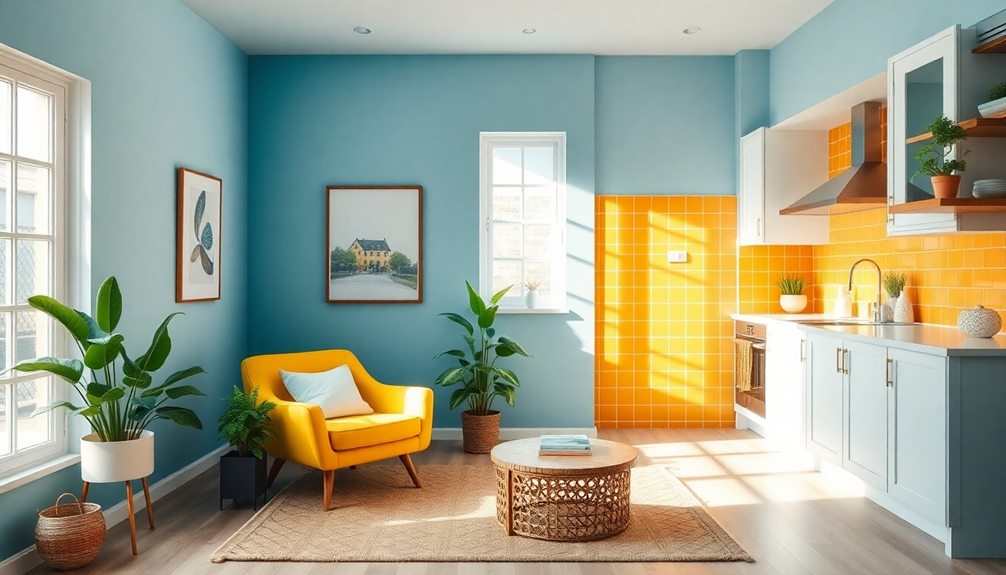
Understanding color psychology helps you create a harmonious home. In your living room, use warm tones like terracotta to invite comfort and conversation. For bedrooms, soft blues promote relaxation, while deeper colors add coziness. In kitchens, warm yellows stimulate appetite, whereas muted greens create a rejuvenating vibe. Your home office can benefit from cool colors like blue for focus and productivity. Finally, choose warm shades in dining areas to spark interaction, while light colors brighten hallways. Each room has a unique emotional impact. Explore these tips to transform your home's atmosphere effectively.
Key Takeaways
- Warm colors in living rooms create inviting atmospheres, fostering social interaction and comfort.
- Soft blues and lavenders in bedrooms promote relaxation and peaceful environments.
- Kitchens benefit from warm colors like yellow and red to boost appetite and energy levels.
- Cool colors in home offices enhance productivity and focus while reducing stress.
- Dining rooms and hallways should use stimulating warm colors to encourage conversation and light colors for brightness.
Understanding Color Psychology
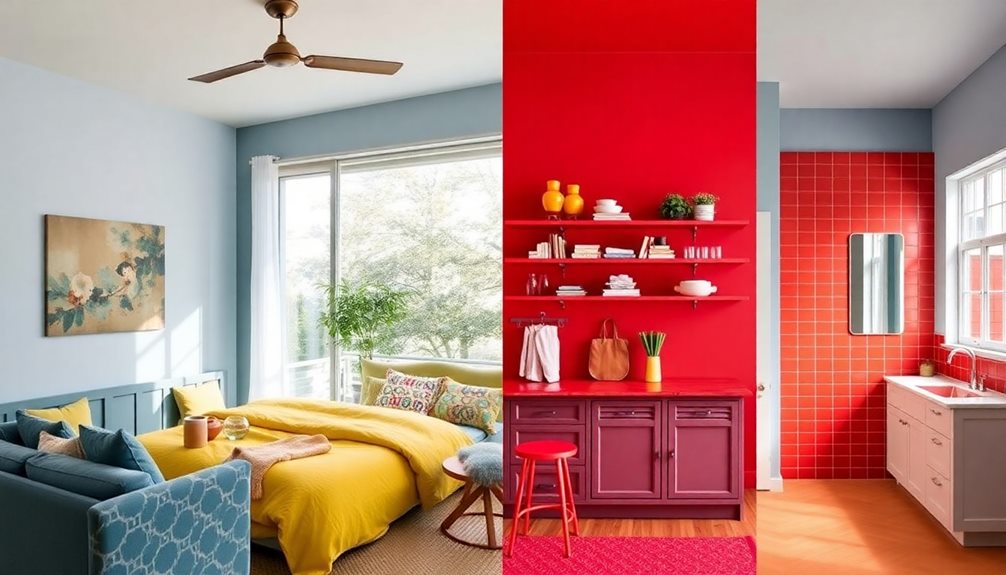
Have you ever noticed how a room's color can instantly change your mood? That's the essence of color psychology, which connects hues to emotional responses. For instance, warm colors like red and orange can evoke energy and passion, making you feel lively and enthusiastic.
In contrast, cool colors such as blue and green promote calmness and relaxation, perfect for unwinding after a long day.
When you choose a color palette, think about the specific feelings you want to inspire. Yellow often represents happiness and optimism, while purple can evoke creativity and a sense of luxury.
However, remember that individual reactions to colors can vary considerably. What calms one person may energize another, so consider your own preferences and those of the people who'll use the space.
Light colors can make a room feel larger and airier, enhancing functionality, especially in smaller areas.
On the flip side, darker colors can create a cozy, intimate atmosphere, influencing how a room is perceived.
Living Room Color Choices
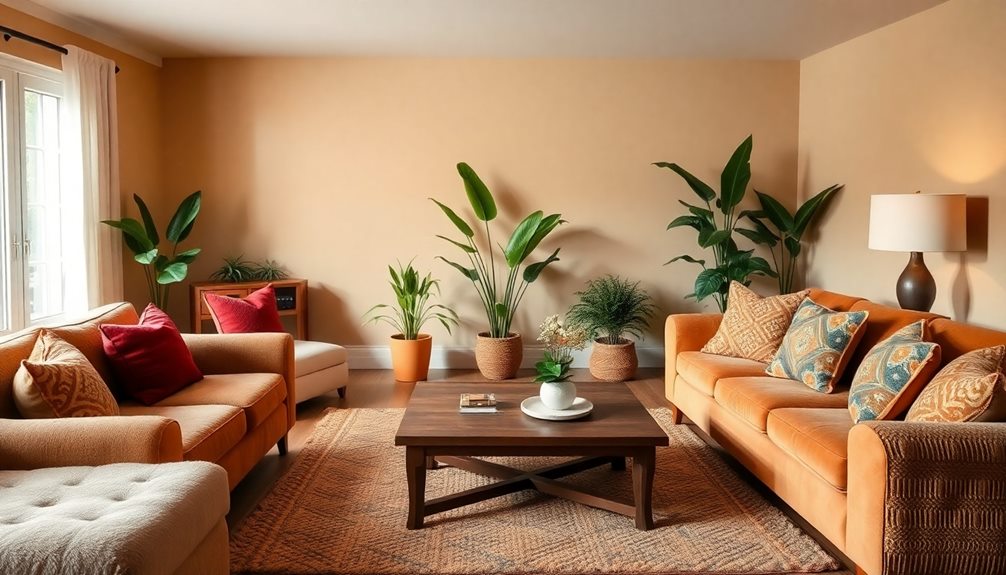
When choosing colors for your living room, consider warm palettes like oranges and reds to create a cozy, inviting atmosphere that encourages conversation.
Adding accent colors can energize the space, making it more dynamic and engaging.
Balancing these choices with neutral tones allows you to maintain flexibility while enhancing the overall ambiance.
Warm Palettes for Comfort
Creating a warm and inviting living room starts with choosing the right color palette. Warm palettes featuring shades of red, orange, and yellow evoke feelings of warmth and comfort, making them perfect for fostering social interaction. Soft terracotta or warm beige can help create an inviting atmosphere that encourages connection among family and guests.
Incorporating warm accent colors, like deep reds or vibrant oranges, adds visual interest without overwhelming the space. Meanwhile, warm neutrals such as cream or light brown balance these bold colors, ensuring a cozy environment.
Optimal lighting—especially natural light—enhances the emotional impact of your chosen colors, making the room feel both spacious and intimate. Here's a quick reference to guide you in selecting your living room colors:
| Color Type | Examples |
|---|---|
| Warm Palettes | Red, Orange, Yellow |
| Warm Neutrals | Cream, Light Brown |
| Accent Colors | Deep Red, Vibrant Orange |
Accent Colors for Energy
Incorporating vibrant accent colors in your living room can energize the space and spark lively conversations. Warm tones like red and orange are excellent choices, as they stimulate energy and create a vibrant social atmosphere.
To keep your design balanced, use accent colors strategically, ideally comprising about 10% of your overall color scheme. This way, they stand out without overwhelming the space. Additionally, consider integrating natural materials, such as wood and metal, which are common in modern farmhouse design, to complement your vibrant accents and enhance the rustic charm.
Consider pairing complementary colors, such as blue accents against an orange backdrop, to create visual interest while maintaining harmony. This interplay enhances the psychology of color, making your living room feel dynamic yet cohesive.
To further boost the inviting atmosphere, incorporate textured fabrics and bold-colored accessories that add depth and liveliness.
Don't forget about lighting! Natural light can greatly enhance the vibrancy of warm accent colors, making them appear more engaging throughout the day. Position your furniture and decor to take advantage of the light, ensuring that your living room remains bright and inviting.
Bedroom Color Selections

Choosing the right colors for your bedroom can greatly impact your mood and sleep quality. For a tranquil environment, consider soft blue or lavender hues. These colors foster a serene ambiance, promoting restful sleep. Warm tones like peach and soft pink can create a nurturing atmosphere, ideal for personal spaces, evoking feelings of comfort and love.
To achieve a cohesive look, think about using a monochromatic color scheme with varying shades of a single color. This approach can enhance the overall feel of the room. Incorporating neutral tones, such as light grays or beiges, can also foster peace and spaciousness, making the room feel more open and inviting.
If you're looking to add depth, consider using accent walls in deep shades like navy or forest green. These rich colors create a cozy, cocoon-like feel, perfect for a restful retreat.
Here's a quick reference table for your bedroom color selections:
| Color Type | Recommended Colors | Mood Created |
|---|---|---|
| Tranquil Hues | Soft blue, Lavender | Calmness |
| Warm Tones | Peach, Soft pink | Comfort |
| Neutral Tones | Light gray, Beige | Peacefulness |
| Deep Shades | Navy, Forest green | Coziness |
Kitchen Color Recommendations
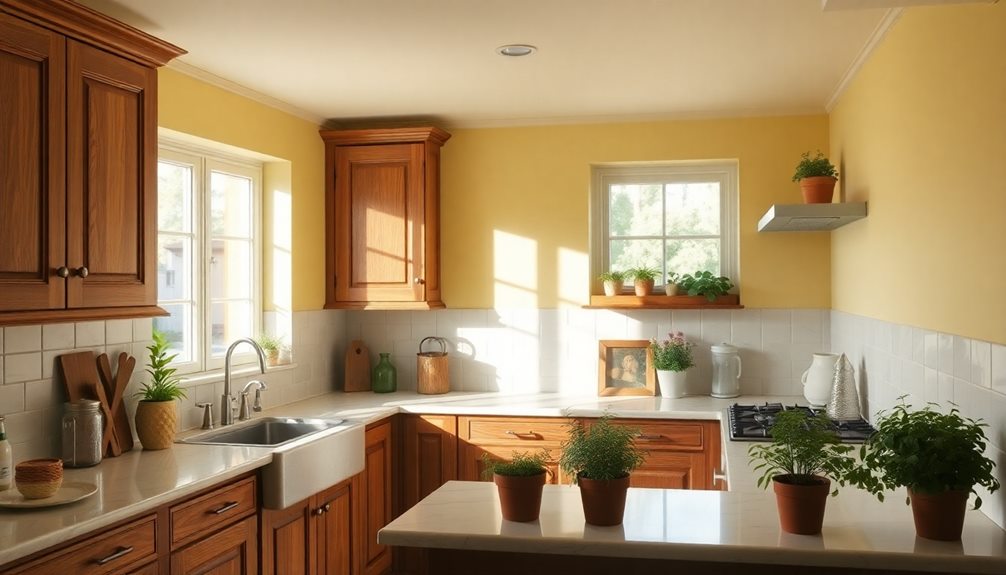
When it comes to choosing colors for your kitchen, warm tones like yellow and red can really boost your appetite and energy.
Additionally, incorporating natural elements, such as the creamy textures and rich colors of butter varieties, can enhance the overall aesthetic and make the space feel more inviting.
On the flip side, cool colors such as green can create a revitalizing and calming cooking space.
Balancing these color choices can help you cultivate the perfect atmosphere for meal prep and enjoyment.
Warm Color Choices
Since warm colors like yellow and orange stimulate appetite and create an inviting atmosphere, they're perfect for kitchens. These hues not only encourage social interaction but also evoke a cozy feel that makes mealtime enjoyable.
Consider incorporating soft warm tones, such as buttery yellows and light oranges, which enhance the sense of spaciousness in smaller kitchens while maintaining that inviting vibe. Additionally, incorporating elements from nature, such as wooden utensils or eco-friendly materials, can further enhance the warmth of the space and promote a sense of sustainability in your kitchen design, aligning with eco-friendly toy choices.
To add energy and passion, you can introduce red accents, which will energize the space and encourage lively conversations. However, it's essential to balance these warm colors with neutral shades, providing visual relief to prevent the room from feeling overwhelming. This harmonious blend allows you to enjoy the warmth without it becoming too intense.
Also, pay attention to your kitchen's natural light. It can greatly enhance the vibrancy of warm colors, making them appear cheerful and uplifting throughout the day.
Cool Color Benefits
Incorporating cool colors like soft greens and blues into your kitchen design can evoke a sense of renewal and cleanliness, creating a calming cooking environment perfect for cooking. These shades promote relaxation and can lower blood pressure, making meal preparation more enjoyable.
Soft greens, associated with energy and balance, emphasize health-conscious cooking, while muted blues enhance the overall atmosphere.
Using cool colors in your kitchen can also create the illusion of a larger space, which is especially beneficial in compact areas. This sense of openness contributes to a harmonious atmosphere, allowing you to feel more at ease while cooking.
When you choose muted tones, you balance out the warmth generated by cooking, ensuring your kitchen remains inviting and serene.
Opting for soft greens and blues can turn your kitchen into a sanctuary, where you can focus on your culinary creations without feeling overwhelmed.
By embracing these cool colors, you not only enhance the aesthetic appeal of your kitchen but also foster an environment that supports relaxation and creativity.
Home Office Color Tips
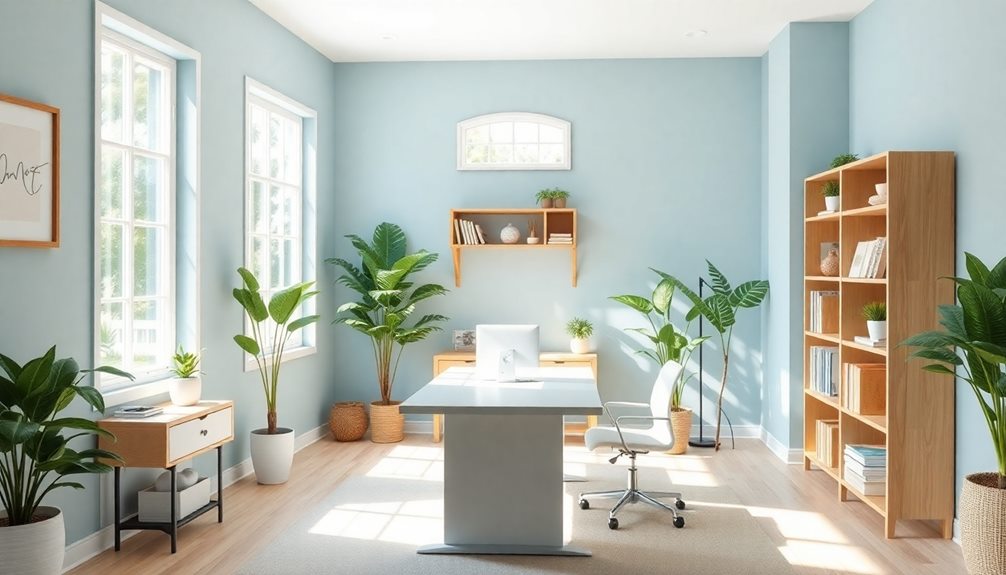
Creating a productive home office often hinges on your choice of colors. To enhance focus and calmness, consider cool colors like green and blue. These hues lower blood pressure and boost productivity during work hours.
If your tasks require creativity, incorporating shades of yellow as bold accents can stimulate enthusiasm and innovative thinking.
To create a balanced and stimulating environment, apply the 60/30/10 rule:
- Neutral Color: Use a neutral color for your walls to create a serene backdrop.
- Medium Tone: Select a medium tone for your ergonomic furniture, ensuring comfort and aesthetics align.
- Bold Accents: Add vibrant accents through accessories or artwork to energize the space.
- Natural Light: Maximize natural light to enhance color perception, making your chosen colors appear more vibrant throughout the day.
Dining Room and Hallway Hues
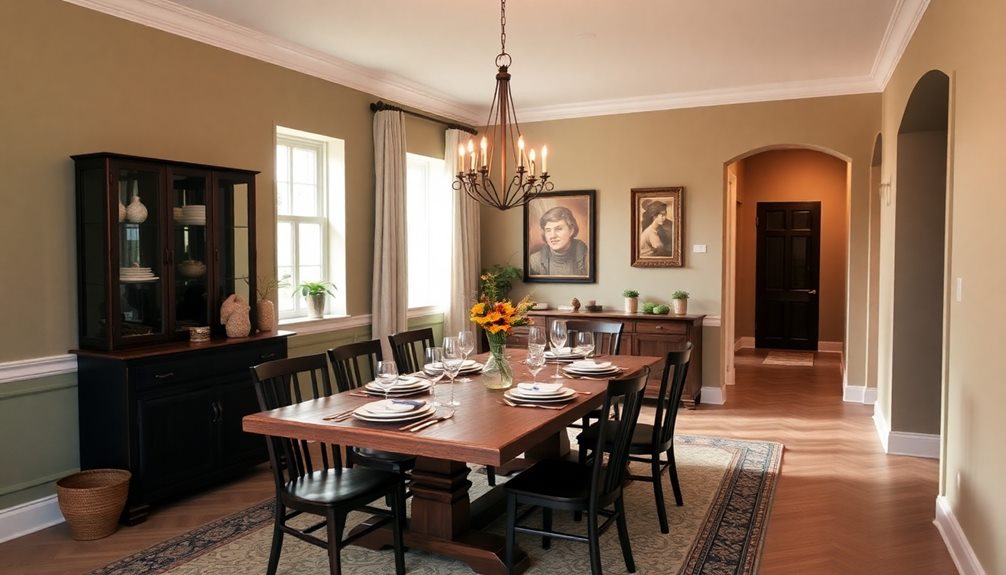
Transforming your dining room and hallway with the right colors can greatly enhance the overall atmosphere of your home.
In the dining room, consider warm colors like red and orange; they stimulate appetite and spark conversation, creating an inviting atmosphere for gatherings. Yellow can also add cheerfulness, promoting happiness and optimism, but use it sparingly to avoid overstimulation.
For hallways, which often serve as narrow passage spaces, light colors such as soft beige or pale blue can brighten the area, enhancing openness and making it feel more spacious. Adding accents of green in hallways evokes feelings of growth and safety, providing a welcoming passage between rooms.
To establish a cohesive flow throughout your home, use complementary color schemes that tie the dining room and hallway together. This not only enhances visual interest but also creates harmony in your design.
Frequently Asked Questions
What Is the 3 Color Rule in Interior Design?
The 3 Color Rule in interior design suggests using three colors: 60% dominant, 30% secondary, and 10% accent. This balance creates visually appealing spaces that enhance mood and atmosphere, making your home feel cohesive and inviting.
What Is the Psychology of Color for Rooms?
The psychology of color for rooms affects your mood and emotions. Warm colors energize social spaces, cool colors promote relaxation in bedrooms, and neutral tones create a clean, spacious feel in kitchens and bathrooms. Choose wisely!
How Do I Choose Colors That Flow From a Room to a Room?
To choose colors that flow from room to room, select a cohesive palette. Use the 60/30/10 rule, test colors in different lights, and guarantee adjoining spaces complement each other for a seamless shift.
What Is the Color Theory in House Design?
Color theory in house design explores how hues impact emotions and perceptions. By understanding primary and secondary colors, you can create harmonious spaces that evoke desired feelings, enhancing the overall ambiance of your home.
Conclusion
Incorporating color psychology into your home design can transform your space and mood. Remember, "a picture is worth a thousand words," and the colors you choose speak volumes about your personality and intentions. By carefully selecting hues for each room, you create an environment that enhances relaxation, productivity, and social interaction. So, take a moment to reflect on the colors that resonate with you, and let them guide your home's ambiance toward a harmonious balance.
Xavier – Your Operations Partner Xavier is your operations partner, working tirelessly behind the scenes to ensure that everything runs smoothly so you can enjoy a seamless experience with Perfect Fit Living. From managing inventory to coordinating logistics, he’s committed to making your experience with us hassle-free.
-

 Vetted6 months ago
Vetted6 months ago14 Best Personalized Father's Day Gifts for Your Husband – Show Him You Care
-

 Alfresco5 months ago
Alfresco5 months agoAlfresco Stacker Doors: Seamless Indoor-Outdoor Living!
-

 Vetted7 months ago
Vetted7 months ago15 Best EMS Foot Massagers for Neuropathy to Soothe Your Feet
-

 Craft and Textiles7 months ago
Craft and Textiles7 months ago15 Best Places to Buy Appliances for Your Home – Top Retailers Reviewed
-
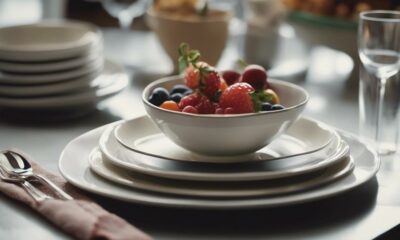
 Tableware and Dining Accessories7 months ago
Tableware and Dining Accessories7 months agoWhat Is the Meaning of the Word Tableware
-

 Vetted5 months ago
Vetted5 months agoBattle Born Batteries Review: Reliable Power Solution
-

 Vetted5 months ago
Vetted5 months agoD-Link Switch Review: Lite Layer 3 Managed Networking
-
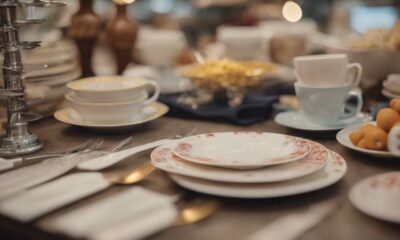
 Tableware and Dining Accessories7 months ago
Tableware and Dining Accessories7 months agoWhen Is Tableware on Sale at Hobby Lobby























